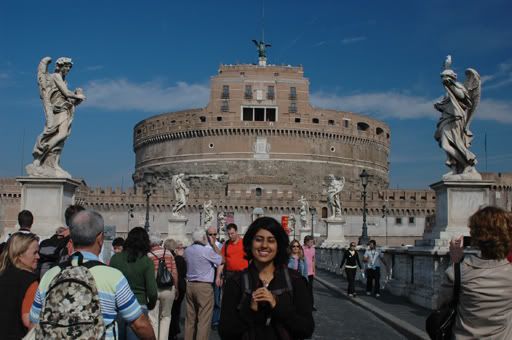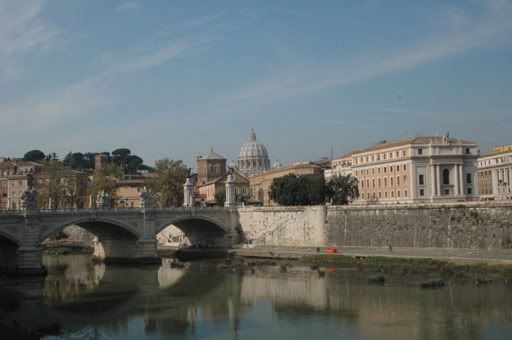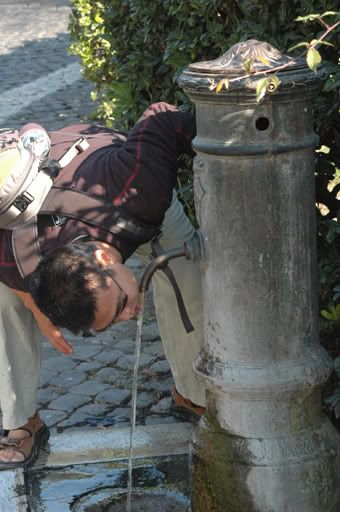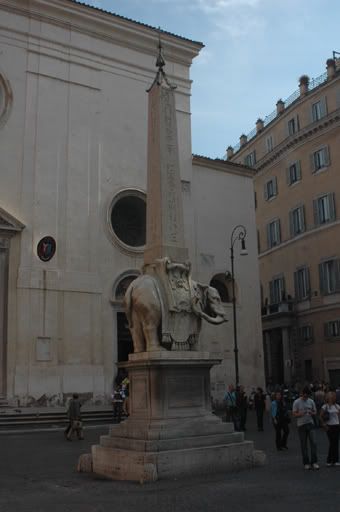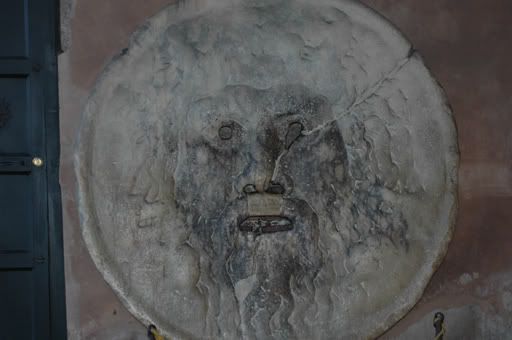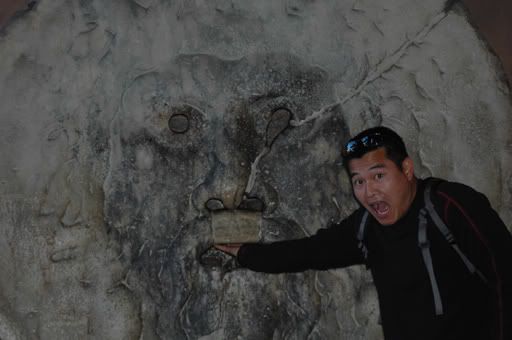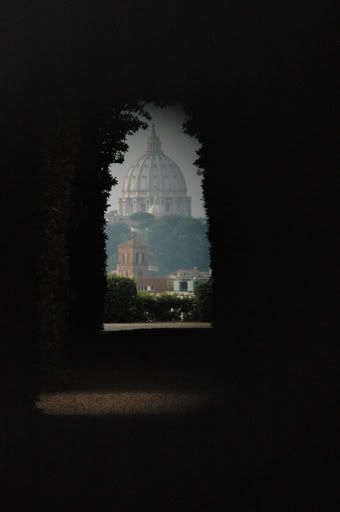We knew Rome would be huge but did not know just how much time to allocate to this rich historical city. To do it any justice we would have to spend a month or so, but time is running out for us here in Europe and there are still so many more places on our long list of places to see. The other factor is the accommodation cost, which is the highest at this time of year due to the good weather. Searching for what we could afford was a losing battle from the start. Everything was in the 100 Euro range, which meant that we could not see or do anything in Rome besides stay in the pension. That would be a crying shame. So we searched relentlessly around the train station, and settled in at the Hotel Biagio for our five days in Rome. The area is a little, no a lot sketchy, but it was the best we could do. The room was a large double that was very clean and bright, and the bathroom was just across the hall, so it was not too bad for 60 Euros a night. The owner, an elderly woman with a husky voice who smoked 12 packs a day was really nice. With the accommodation settled, lets take a closer look into Rome’s historical background.
Rome’s origins seem to date back to mythology more so than history. It is said that Romulus founded Rome in 753 BC. For those of you who read the blog, this goes back to our visit in Segovia, Spain where we were unsure what a stature of two small children suckling on a she-wolf was all about. Thankfully, Tara was able to explain the meaning behind the statue and now after being in Rome we are a little more knowledgeable about the story behind it all. It is believed that Romulus and Remus were born from a vestal virgin and at the time, a vestal virgin who broke her chastity couldn’t have her blood shed and therefore was buried alive. Romulus’ and Remus’ mother though vowed to the people that their father was none other than the god of War and therefore they were all linked to holy blood. The vestal virgin was therefore saved from being buried alive but as punishment the children were left on a raft and sent down the Tiber River. It is during this time, that it is thought that a she wolf came across the two boys and nurtured them, as their mother would have. But all the nurturing in the world couldn’t deter the dark side of human nature. Shortly after the brothers founded Rome, legend has it that Romulus killed his own kin. This tradition of internal conflict reappears throughout the course of Rome’s history.
The Roman Republic was founded in 509 BC and it was a major power in the Western World until internal rivalries led to civil war. There was Julius Caesar vs. Pompey and then Mark Antony vs. Octavian who all fought for the top job. It was Octavian who prevailed in the end and with the blessing of the Senate, became Augustus, the first Roman Emperor. During the reign of Augustus, Rome enjoyed a period of political stability and artistic achievement. In the years to follow, Rome would go through a series of ups and downs where it seemed it was at supremacy at times and then plummeted to its own demise other times.
After Christianity spread through Rome in the 1st century AD, no thanks to the underground efforts of apostles Peter and Paul and ruler Constantine, it appears it was this movement of religion and setting home in the fortified Vatican by Pope Gregory XI, that helped to make Rome what it is today. It was in 1377, that Rome emerged as the city of Renaissance through major projects such as the Sistine Chapel and St. Peter’s Basilica.
Despite further attacks and further rebuilding, Rome today is one of the most visited cities in Europe by both tourists and pilgrims alike. This is evident by the influx of around 16 million Catholics that entered the city during the Jubilee Year of 2000 and the amazing 3 million mourners that filled the square outside St. Peter’s Basilica to pay their respects to the late Pope John Paul II in 2005.
A city so rich in history, religion, architecture, and life is bound to be a city worth visiting as we have been lucky enough to witness. Lets now rewind 5 days and start “roaming” the streets…
Rome like no other city has this paradoxical nature to it, being both alive and dead simultaneously. From the plethora of Roman ruins (the Colosseum, Roman Forum, the Palatine) scattered throughout the city that lie dormant in the lively urban fabric of Rome in the 21st century to the venerable basilica alive with activities of pilgrims and tourists yet it being the final resting place for saints and popes, to the numerous churches under constant renovation to restore them back to the splendors that they once were as if to repair the faith of man in Christianity. It is this underlying quality that we found to be entrenched in all that is Rome.
COLOSSEUM
The first time I ever saw the Colosseum was when Bruce Lee kicked the crap out of Chuck Norris in the movie 'Way of the Dragon'. The next time I saw it, was of course at school in Ottawa, but the third time, I actually saw it up close and in person. All of the rich marble decoration of its glory days have been stripped clean for other monumental buildings that came after it like that of St. Peter’s Basilica in the Vatican City and St. Paul’s Basilica in London. What remains is the skeleton of an engineering feat rivaling modern day mega giant construction like the twin towers of Kuala Lumpur. The structural components consisting of brick and mortar and large stones weighing over 5-6 tonnes each seem to lie in the centre of Rome unbeknown, that is until the tourists arrive. Unlike the spectators of the past that gathered here in the thousands, 50,000 to be exact, to pay witness to the torturous and dangerous games of life and death of the gladiators, the new spectators are not here for the blood that once shed within the walls of the Colosseum but rather they are here to visit the Colosseum itself. Perhaps paying homage to the building. The 80 entrances would have made access into and out of the Colosseum easier but today, only one entrance is permissible which makes the line ups rather long as bus load after bus load of tourists make their daily visit.


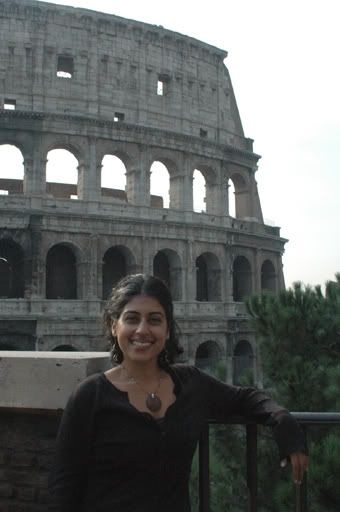

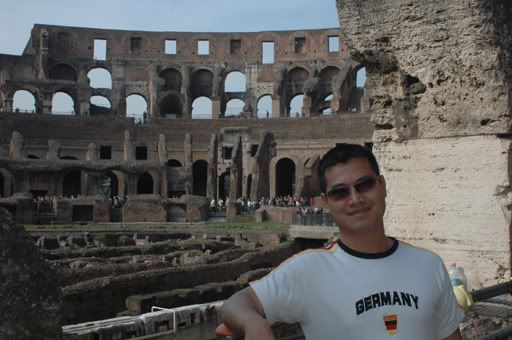

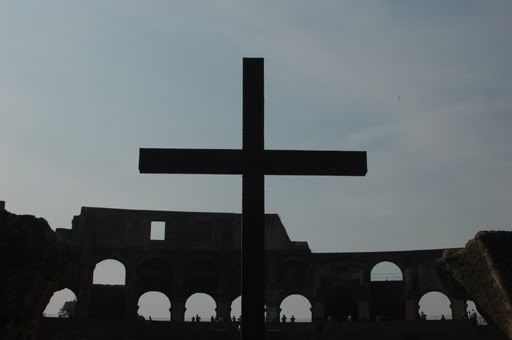
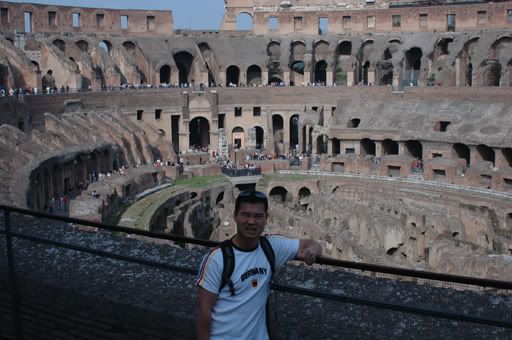
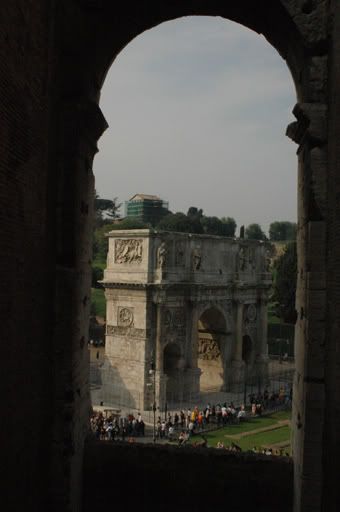
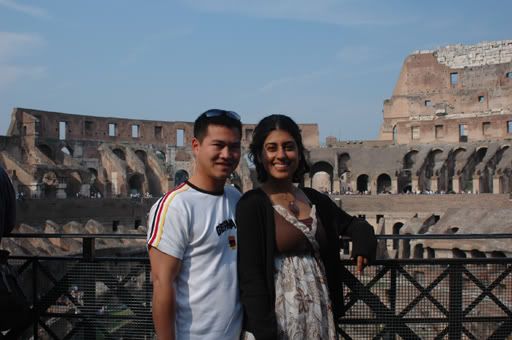
ROMAN FORUM
In ancient times, a forum was a shopping mall, a civic center, and religious complex all in one. They were dramatic public spaces, richly decorated in a grandiose scale. Today you need quite a bit of imagination to fill in the pieces of the missing portions of the forum to get a glimpse into the past. Even with an audio guide it was very problematic in deciphering just what exactly we were looking at. A few columns here and there are usually all that is left of what once must have been the place to see and be seen. The once toga filled streets with senators, and wealthy citizens roaming about is now replaced with tourists trying desperately to imagine what it once was. By the puzzled looks on most of these site seekers (us included), we could tell that ancient Rome is still pretty much a mystery, in spite of the fact that we were standing on it, in front of it, behind it or beside it, with guide books and audio guides, it made no difference. The 4 Euro audio guide added more confusion to the walk rather than enlightening us. Most of what we heard through the ear piece was also written in the guide book we got, and the map in the guide book was more effective than the one we got with the audio guide.
There is really not much of a point to identifying each of the sections or specific buildings as it would not make much sense to anyone, including us and we had spent 4 hours there.
Originally it was an Estruscan burial ground, expanded to become a gleaming heart of the Roman Republic in the 7th century BC. By the 4th Century AD it had become a pastureland and most of its rich décor was plundered by Roman descendants to build new palaces, churches, and monuments. During the Renaissance era, the decaying forum and all of its shattered monuments became a source of inspiration as it housed classical elements.
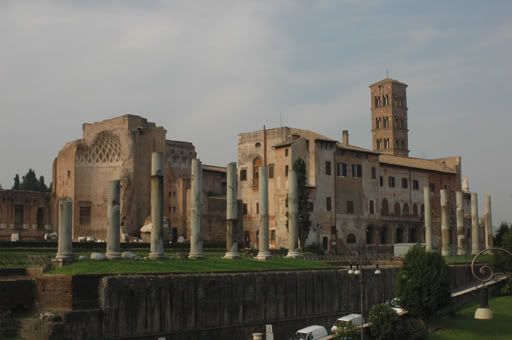
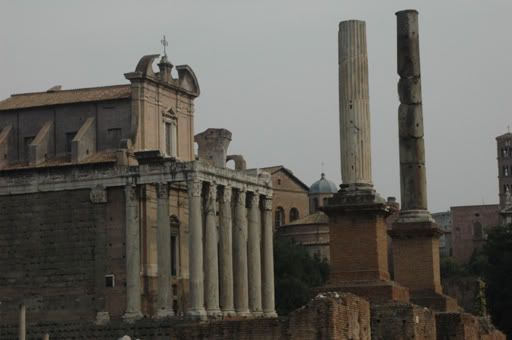

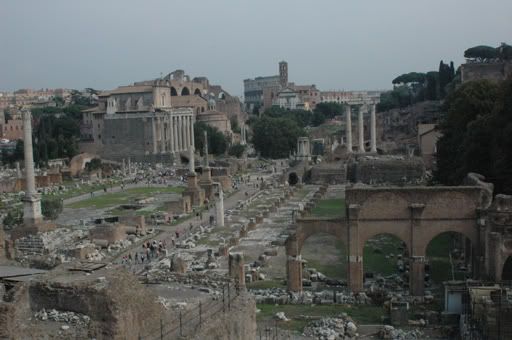
PALATINE
Legend has it that Romulus had killed his brother Remus and established what later came to be known as Rome here in the Palatine, which later housed aristocrats and opulent palaces for emperors of the time. After the decline of the Roman Empire and the rise of the medieval ages, churches and castles were built over the ruins of previous emperors.
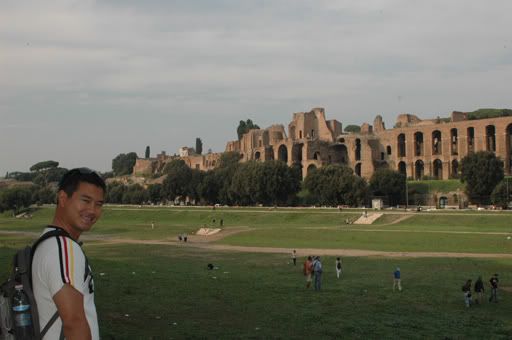
One impressive feature of the ancient ruins of Rome is the fact that it is scattered in a much larger area than most cities we have been to, where the old quarter is concentrated in a small area. The remnants of the splendor of Rome are everywhere, and they continue to find more as excavations are currently underway to add a new metro line into Rome to ease the congestion of daily traffic. The last two subway lines took over twenty years each to build, so I wonder just how long this third one will take. It is ironic that the ancient Romans could build aqueducts as far as Segovia and Constantinople, but the current Romans can not add a new metro line. These massive buildings lie decrepit and decaying in the midst of the lively and energetic activities of 3 million inhabitants. It is this contrast in reality that is most striking, the old and new cohabit within the rich historical context of Rome.
ST. PETER’S BASILICA
The holiest of all Catholic churches is St. Peter’s Basilica, dedicated to the patriarchal saint Peter who was crucified upside down at this very location some 2000 years ago for advocating Christianity.
The very first basilica that was built in the same spot as St. Peter’s today was built by Rome’s first Christian emperor, Constantine, in the 4th century. More than 1000 years later, the basilica had fallen apart and many tried to rebuild this holy shrine. It took more than 150 years to build the new church that we see today and its construction is owed to many talented artists such as Bramante, Bernini, Raphael, Maderno and of course, Michelangelo. Michelangelo is responsible for the design of the spectacular dome of St. Peter’s Basilica, which in one word can be stated as breathtaking.
The basilica that we see today is the same one that was artistically created back in the days of the high Renaissance period. Construction of the new basilica took place in the early 16th century and took 176 years to complete. Although the design of St. Peter’s Basilica changed hands many times and thus went through many iterations during the course of it’s construction, one thing remained constant - that is the underlying theme to overwhelm the masses. To do this, the architects used their vast knowledge of perspectives and manipulated this in such a way to make the appearance of this holy place attainable by the general public. As the holiest church in the entire western world, St. Peter’s Basilica is perhaps not only the tallest, the biggest but also the grandest of them all. However, the overall size of St. Peter’s Basilica is not really fully rationalized by the general public, as statues of the 12 Apostles adorning the exterior front façade of the basilica are three times larger than that of an average man, and the Saints that stand on top of Bernini’s colonnade are twice the size of an average man. This manipulation on scale distorts the overall perspective of the entire basilica as a whole making the viewer think that the space that they are standing in seem not as big as it really is. In a true perspective, the statues of the Apostles and Saints if designed at true human scale would appear to be much smaller due to the fact that they stand at 55m (equivalent to a 17 story building) above the ground. Perhaps this was done to illustrate the pilgrim’s relationship to God – the perception of the physical distance between the viewer and god is greatly reduced by the enlargement of the apostles and saints. The magnificent basilica becomes even more impressive as you enter into the interior spaces of the church. The décor and plays of light and darkness appeal to your overall senses and the majestic space under the dome is one of pure awe. Words can only say so much… so here are some of our pictures from the day we visited St. Peter’s Basilica.
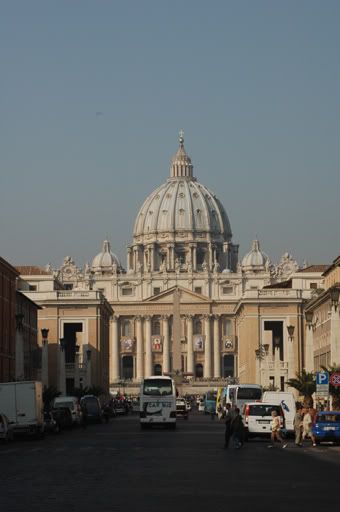


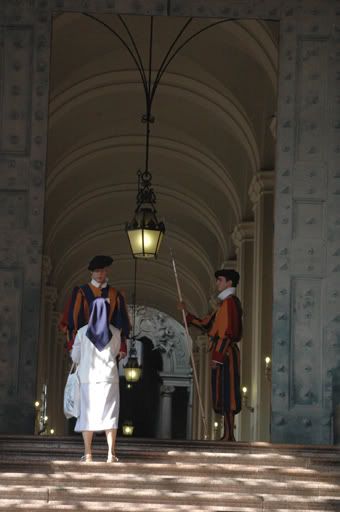
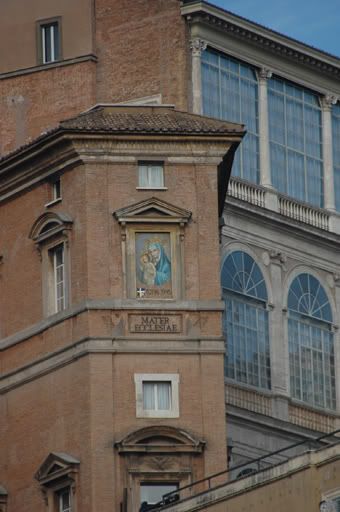

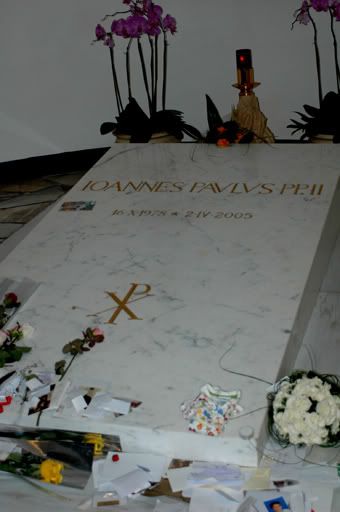


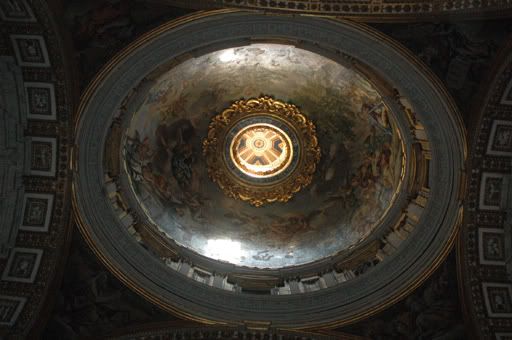



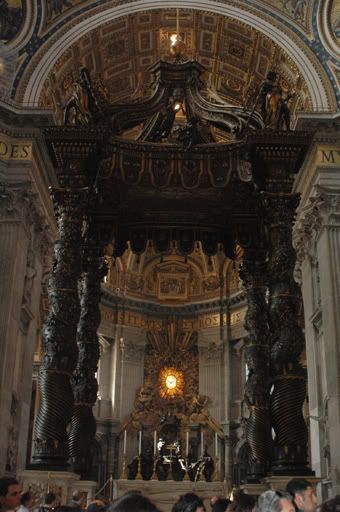
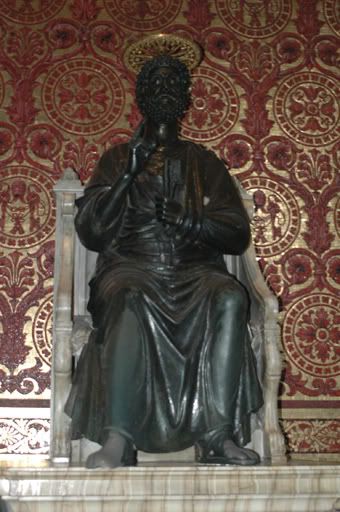
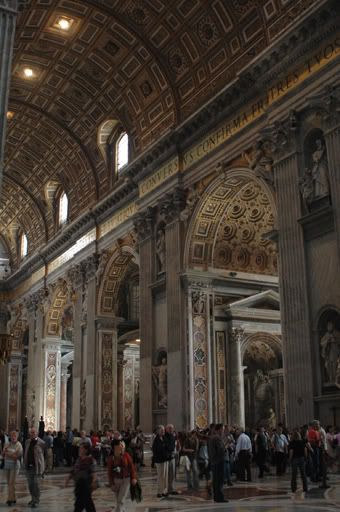
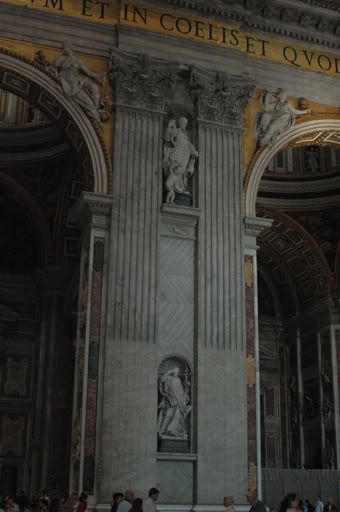
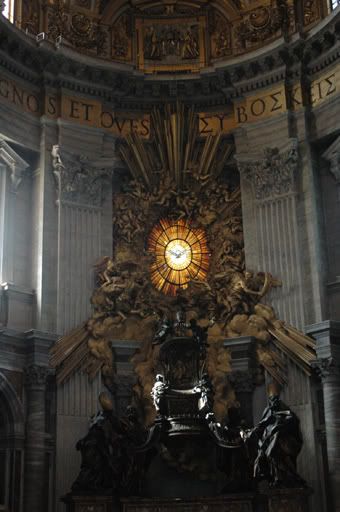

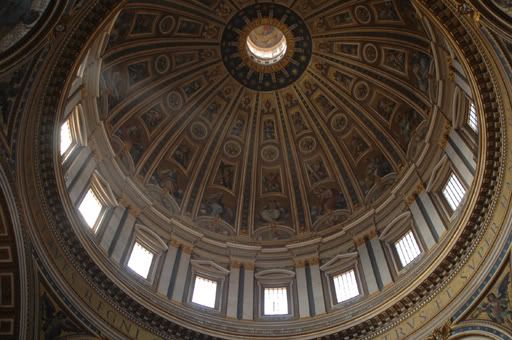
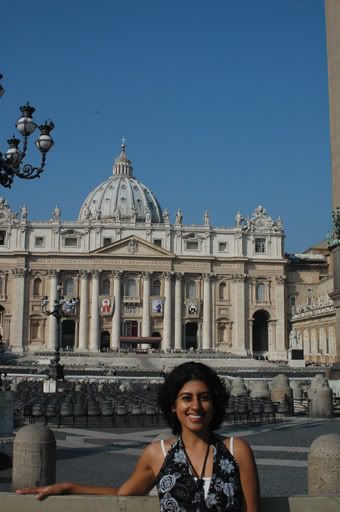


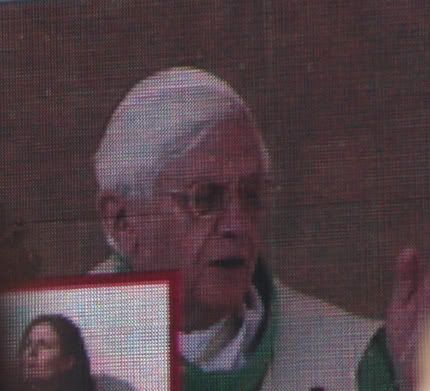
Walking to St. Peters Basilica is like making a pilgrimage - one that can affect any individual whether you’re religious or not. Perhaps this is one of the reasons behind building a church of such richness and grandeur, to not only appeal to the religious and Catholic but to also be a haven for all others to adore and appreciate. This was our frame of thought as we zigzagged through the maze of streets and whizzing cars to get to St. Peter’s. There was a sense of anticipation as we drew closer to the church and caught glimpses of the dome between the low lying buildings that stood between us and the masterpiece. Once we crossed the bridge into the Vatican City, our pace quickened unconsciously, like an infant stumbling into the arms of their parent. As we grew closer, we were both so overwhelmed by the architectural appearance of the basilica that neither one of us paid attention to the excessively long line of tourists waiting in queue to enter. A few years ago, we would have been able to walk right into the church without having to wait in line but since the Twin Towers attack in 2001, they have increased security measures and now enforce everyone to go through a metal detector.
We were contemplating whether or not to join a tour or purchase a book to fully appreciate all that we would be seeing inside the church. As we hummed and hawed while waiting in line, we overhead someone advertising a free tour in English. Guess God was reading our minds. We reluctantly relinquished our spot in line to join this so called “free” tour (we were thinking what you’re all thinking, who does anything for free nowadays!!). To our surprise, the tour was extremely informative, the tour leader was funny and Canadian (go figure) and it was FREE!! No strings attached but if you wanted to join the 2nd half of the tour that day to view the Vatican Museums, there was a cost for that one. We opted out of the 2nd tour not only because it cost a lot of money but because we had also decided to purchase a book which we could keep as a souvenir as well. Now back to our thoughts of the interior….
How does one describe something so elegant, overpowering and beautiful?? Let’s just say we were both dumb founded as we entered the church and the look of awe on Rav’s face pretty much said it all. No words can describe the sensations that overcome you as you just stand there and marvel at ALL that is around you. This one, you just have to come and experience for yourselves. You’ll then understand what we can’t seem to describe in words.
VATICAN MUSEUMS
After finding it very difficult to pry Rav away from St. Peter’s, we slowly made our way towards the entrance to the Vatican Museums – an area that covers only 5.5 hectares. We had heard that the line up for the museums can be as long as 2 to 3 hours but we were lucky enough to only have to wait around ½ hour before entering. We were unsure if there would be enough time to see and appreciate all of the work on display as it is a known fact that you can easily spend 12 years here if you spent only 60 seconds with each art piece. That would mean all of our friends would have to subsidize us for the next 12 years of our life…so we decided 2 ½ hours would be enough (but for those of you who are still interested in sponsoring us, please drop us a line at http://chris-rav-abroad.blogspot.com and we can provide you with necessary details).
With our guide book in hand, we began to maneuver through the crowds as we made our way through the various rooms and galleries appreciating the art before us but at the back of our minds always thinking of the Raphael rooms and the Sistine Chapel that lay ahead.
The Raphael rooms were something else. If you don’t know who he is or what he did, please do not confuse him with sewers and turtles, this Raphael is the arch nemesis of Michelangelo. His paintings that adorn the walls of these rooms are more than just paint on walls, they are animated characters that come to life to tell their story regardless of what language you speak. Raphael’s mastery came from his use of light and color to emphasize the dramatic events of the Bible.
Although we could have spent more time in each of these rooms, closing time was approaching and we wanted to get our moneys worth (12 Euro per person) and see the Sistine Chapel. The last room in the exhibition was cram packed with people straining their necks to see what was painted on the ceiling. The room would fluctuate between bouts of silence and the excited whispers of viewers only to be broken by the screaming guards telling everyone to be silent. Understanding that this is a holy place, we tried to keep our whispers to a minimum but you know Rav, hard to keep her quiet. She was overly enthused at all that was above and around her. Not only was there Michelangelo’s celebrated ceiling but on the two flanking walls were murals of the Old Testament and New Testament by various artists including Botticelli, Ghirlandaio, Pinturicchio and Signorelli and add to that the grand Last Judgment painted by Michelangelo. It was a lot to take in and not enough time, we could have easily just spent the entire day in that one room gazing at masterpiece after masterpiece. Unfortunately, they do not allow photography in the Sistine Chapel to of course preserve the paintings. Just another reason to come to Rome I guess….that or you can borrow the book we got.

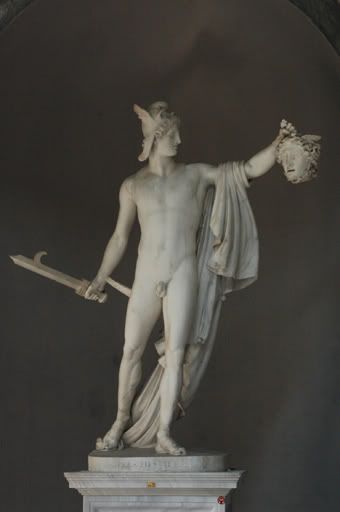
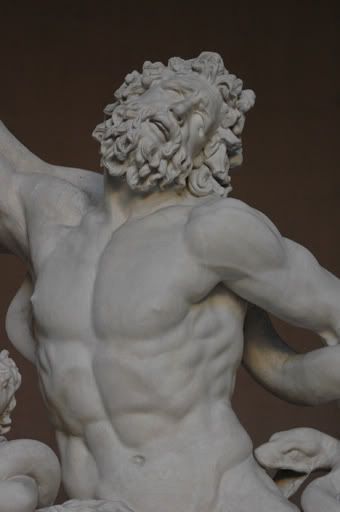

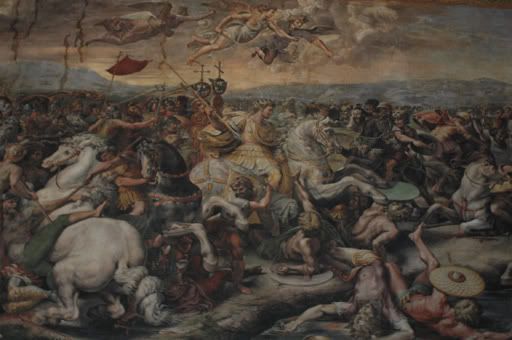
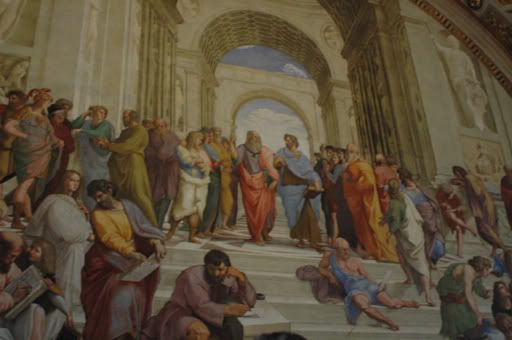

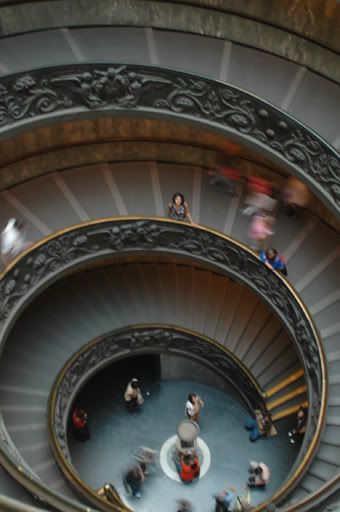
We could write pages and pages of our time in Rome but one, we know most of you like the pics more than the write ups and two, we have other things to experience (like the vino that is waiting for us)!! So here are a few of the other 900 churches that Rome has to offer….
BASILICA DI SAN GIOVANNI IN LATERANO
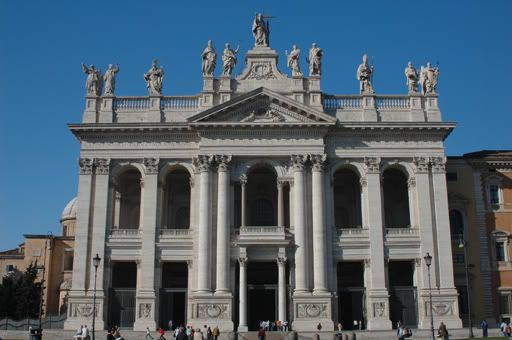
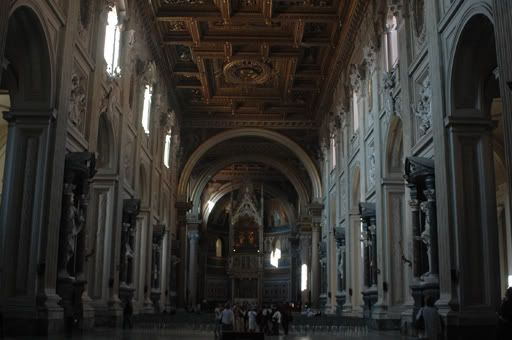
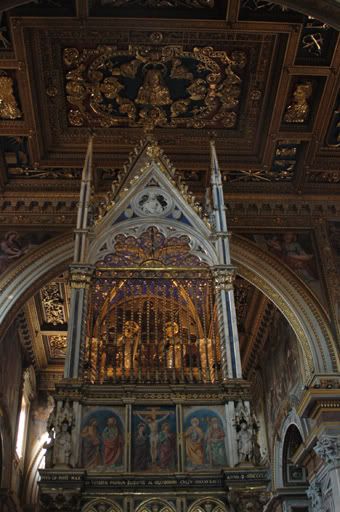

SCALA SCANTA
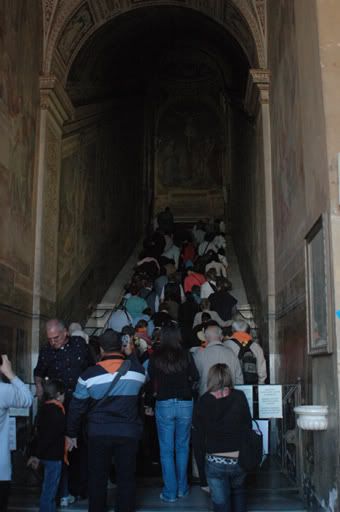
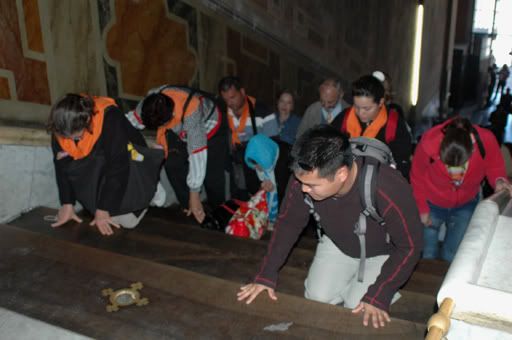
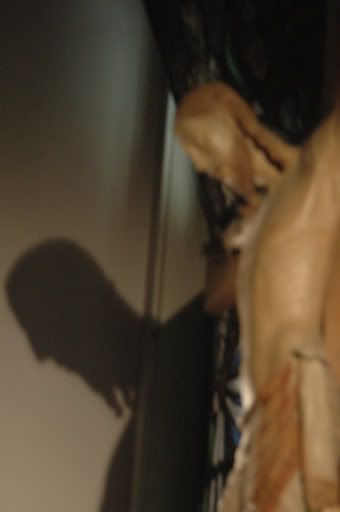
OTHER CHURCHES
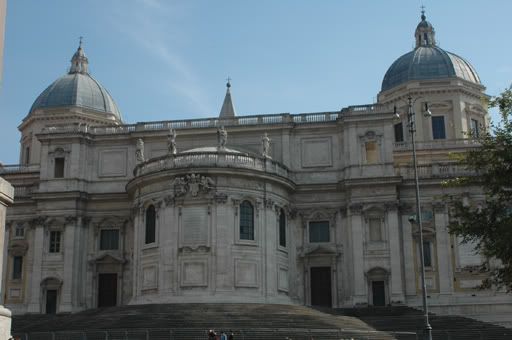
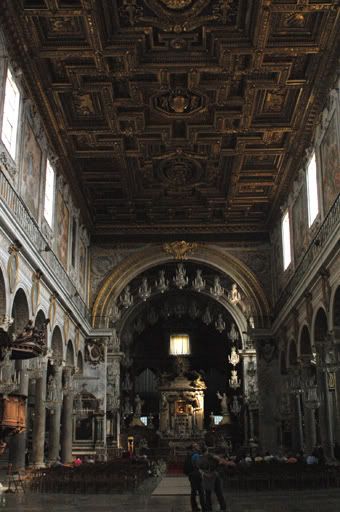
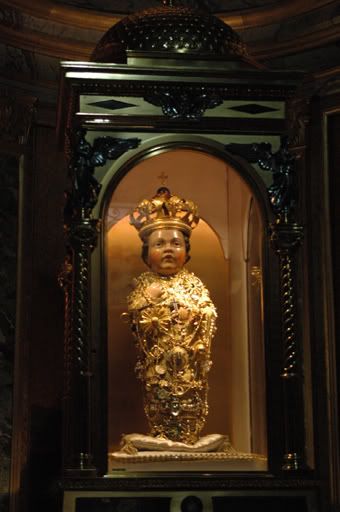

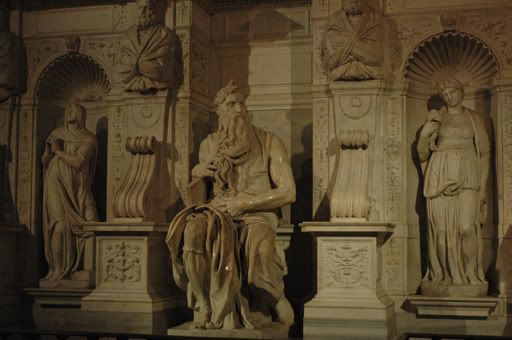
PANTHEON
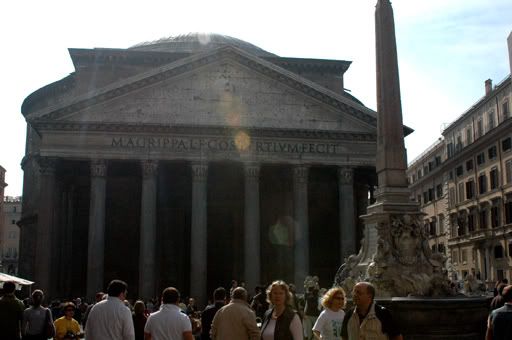

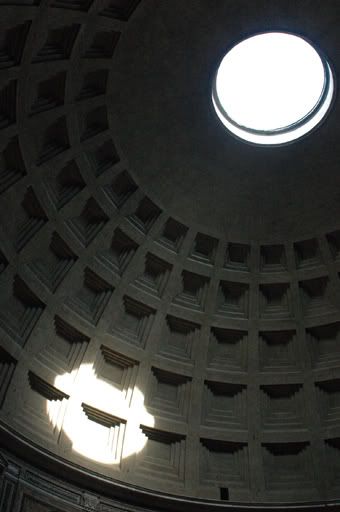
Like all churches, this church is dedicated not to the living but to the dead. Here, saints and popes are laid to rest where millions upon millions of pilgrims congregate each year. The spiritual nature of St. Peter’s Basilica is embodied within and around the building itself. Bernini et al have created the ultimate shrine to elicit the power of the Father, the Son, and the Holy Spirit, but more importantly, in that of Man. As statues of saints remind us of the ultimate sacrifices, it is in death that Jesus shows us the meaning of Life.
Similarly, the Vatican Museum is a pictorial representation captured by masterful artistry of the events in the Bible and the lives of kings, emperors and popes whom have dedicated their lives to their Faith. These images are frozen in time, some even decaying, but are brought back to life by the faithful and agnostic observers of today. In this sense, they breathe new life into what has been dead for so long.
The dominance of the Vatican did not hinder the construction of other churches throughout Rome. There are over 900 churches in the city of Rome, some more spectacular than others, but all serving the same purpose – that is to instill the teachings of Christianity. Each has a story to tell and together, they complete the history of 2000 years of Christian thought but always going back to the same events of the Bible to instill the ideas into new generations.
SOME PIAZZAS OF ROME
Two things that come to mind when I think of piazzas in Rome are great monuments and the street hawkers and buskers that use these touristy squares to make a living. The impressive sculptures and fountains of the Renaissance era brought to life by masters such as Bernini, Borromini and Salvi are situated in piazzas that draw millions of visitors annually. But there is more to it than just these inspiring pieces of art, there are the lively activities of every day life for some of Rome’s inhabitants. They are many in number, selling the strangest things, like bubble making toys, battery operated cars that run in circles, magnets, and stress balls that can be stretched and pulled into different directions. If you refuse one of these men trying to sell you one of these stress balls or what ever they are selling, you will see his friend in a couple of minutes trying to sell you the exact same thing. They always approach you with a cautious eye, one fixed on you and the other scanning the vicinity for police patrolling these areas. Their shop is nothing more than a shopping bag full of what ever it is that they are selling. These animated salesmen are in complete contrast to the motionless figurines of the sculptures and fountains that the tourists like us come to see. For them it is more than just a public square it is their place of work, their way to make a living when all else has failed. This is not unique only to Rome as we have witnessed this in all of the countries we have been to thus far, but it became more apparent to me in Rome.
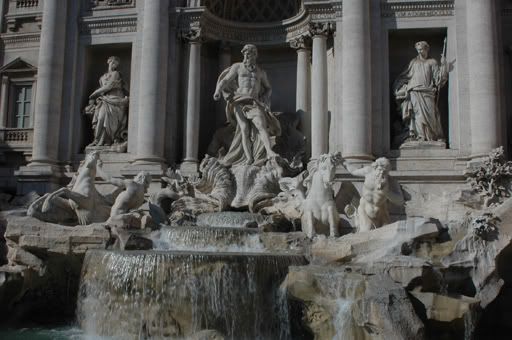
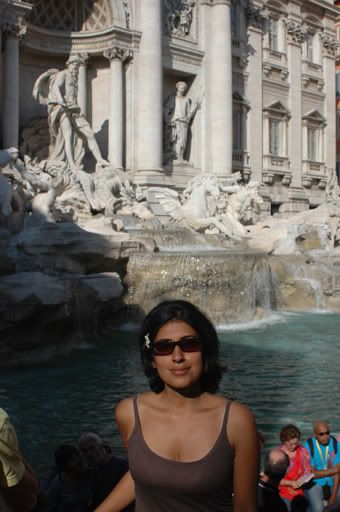

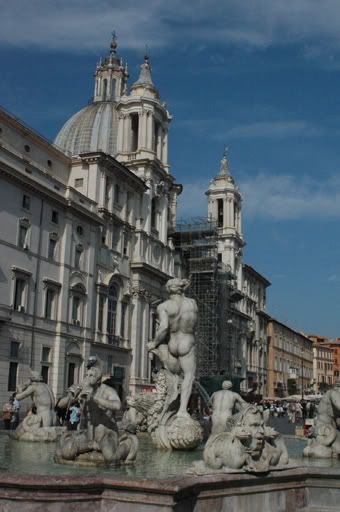

Okay, so that’s day 1 in Rome…….just kidding….that was just half a day!! I’m sure you get the point, there is so much to see and do in Rome that we’ll definitely be back in the future. Until then….here are some of the other things we saw “when in Rome”
Chunger the unemployed bum


